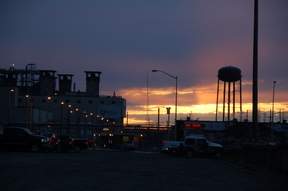

Vale has reached an agreement-in-principle with the federal government that will allow it to continue to operate its 53-year-old smelter in Thompson until sometime in 2018, say mayoral candidate Luke Robinson and USW Local 6166 president Murray Nychyporuk. Pending environmental sulphur dioxide (SO2) airborne emission standards that were due to come into effect in a few months, as applied to Vale’s Manitoba Operations, would have required its closure if Vale couldn’t meet the standards. The new standards would require a reduction in airborne emissions of approximately 88 per cent from current levels at the Thompson operation, Vale has said previously.
More than 30 per cent of Vale’s production employees in Thompson work in the smelter and refinery. Employees hired before Oct. 1, 2011, have the option to transfer to the mill or underground to the mines from surface operations when the smelter and refinery close under the company’s transition plan.
The announcement that the smelter and refinery would close was originally made on Nov. 17, 2010, with Vale saying at the time it was “phasing out of smelting and refining by 2015” in Thompson. Mining and milling operations are slated to continue.
Almost two years later, in October 2012, Vale announced a possible one-year extension for the Thompson smelter and refinery, contingent on federal sulphur dioxide (SO2) emission standards approvals, to no later than Dec. 31, 2015 because of construction delays at the now open state-of-the-art hydromet processing facility in Long Harbour in southeast Newfoundland on Placentia Bay on the western Avalon Peninsula, about 100 kilometres from St. John’s. It will also process sulphide concentrate feed produced at Voisey’s Bay in Labrador, which has been processed in Thompson. The Long Harbour plant is Vale’s first processing facility in Canada located on tidewater. Long Harbour was originally scheduled for completion in the first quarter of 2013.
Robinson, a first-term incumbent councillor, running in the Oct. 22 municipal election for the open mayoral seat being vacated by Mayor Tim Johnston, who is not seeking re-election to council, against Dennis Fenske, another first-term incumbent councillor, who is Vale’s engineering supervisor of support services for central engineering and the project management office here, said Sept. 22 at a regular council meeting Vale has reached an agreement with the federal government on the sulphur dioxide (SO2) emission standards that will allow the smelter to stay open into 2018. Robinson is a mechanical underground worker at Vale.
The Thompson smelter and refinery, which opened March 25, 1961, was the free world’s first fully integrated nickel operation and built at a cost of $185 million.
The Canada-Wide Acid Rain Strategy for Post-2000 was agreed to in 1998 by federal, provincial and territorial ministers of energy and environment to fulfill an earlier commitment in their 1994 “Statement of Intent on Long-Term Acid Rain Management in Canada,” which in turn built on the 1985 Eastern Canada Acid Rain Program. Sulphur dioxide emissions in Canada have decreased 63 per cent since 1985, thanks mostly to a reduction of the amounts produced by base metal smelters due to a combination of a code of practice and implementation of pollution prevention plans, the Winnipeg-based Canadian Council of Ministers of the Environment reported last year. The president of the council is Manitoba NDP Minister of Conversation and Water Stewardship Gord Mackintosh.
Their 2010-2011 progress report on acid rain strategy for after 2000, released early last year, reported that Manitoba was the third-largest emitter of sulphur dioxide (SO2) in Canada in 2010, accounting for 14 per cent of the total, behind only Alberta at 27 per cent and Ontario at 20 per cent.
SO2 emissions from Manitoba in 2010 were down 44 per cent from their 2008 level, to 197,000 tonnes from 350,000 tonnes, thanks in part to the closure that year of Hudbay’s copper smelter in Flin Flon, which was expected to reduce total emissions of SO2 by 185,000 tonnes per year. That was the largest relative decrease in S02 emissions in any province over the same two-year period.
The scheduled closure of Vale’s smelter in Thompson is expected to reduce the amount of sulphur dioxide emitted in Manitoba by another 185,000 tonnes, the report said. Together, those two smelters in Flin Flon and Thompson had accounted for the bulk of the emissions produced by the nonferrous mining and smelting sector, which was responsible for 98 per cent of all SO2 emissions in Manitoba.
Liz Dykman, programs co-ordinator for the Canadian Council of Ministers of the Environment, told soundingsjohnbarker (https://soundingsjohnbarker.wordpress.com/) Sept. 25 the “2010/11 report is indeed the latest report on the Canada-wide Acid Rain Strategy for Post-2000. A 2012/13 report is currently being drafted. CCME does not have any more recent reports on refinery and smelter mining operation SO2 emissions.”
USW Local 6166 president Murray Nychyporuk said in an interview Sept. 25 with soundingsjohnbarker he believes the deal with Vale the federal government, which was discussed by the bargaining teams during recent contract negotiations, is essentially an agreement-in-principle that would allow Vale to continue to operate the smelter and refinery through some point in 2018 on environmental grounds.
Nychyporuk said it’s not clear to him at this point if the deal would run right until the end of 2018 on Dec. 31.
He also said he understood agreement-in-principle means there will likely be some public comment period, for perhaps written comments or a town hall meeting, where people would have the opportunity to make representations on the issue of the new sulphur dioxide (SO2) emission standards not going into force for Vale next year, as previously expected, before the federal government grants its final environmental approval.
Nychyporuk also said it is important to keep in mind also that environmental approval is not the same thing as a business case for Vale keeping the smelter and refinery open into 2018, although he suggests it is unlikely the company would jump through all the necessary legal regulatory environmental hoops to keep the smelter and refinery open if they didn’t plan to carry on operating it during at least most of the extended three-year period. However, Nychyporuk said nickel is a cyclical market, subject to wide price swing flucations, and a big downturn in nickel prices, or the need to do major capital repairs at the smelter if something big should break down, could influence the company to close it before 2018 even with an environmental green light. Conversely, a strong market and high demand might mean Vale will want to keep the smelter and refinery open even beyond 2018, he added, saying there is just no way of knowning that this far in advance. “I don’t have a crystal ball,” Nychyporuk deadpanned.
Nickel was selling on the London Metal Exchange (LME) Sept. 25 for a spot price of around US$7.82 per pound. At the beginning of 2014, nickel was about US$6.50 per pound, compared to just under US$8 per pound a year earlier. Nickel prices peaked at US$25.51 per pound on the LME in May 2007 just months after Vale bought Inco in a US$19.9-billion all-cash tender takeover offer deal in October 2006. Mining is a cyclical business involving finite resources. Manitoba Operations produces nickel, copper, cobalt and has associated gold, silver, platinum, sulphur, selenium and palladium deposits.
Mark Scott, general manager of mining and milling for Vale’s Manitoba Operations, sounded a cautionary note on the possibility of the smelter and refinery remaining open beyond next year when he spoke to about 30 members and guests at the Thompson Chamber of Commerce’s weekly luncheon May 28, saying the “base case remains” that they both “will close at some point in 2015.” In addition to sulphur dioxide (SO2) emission standards issues, there also remained questions over availability of nickel sulphide concentrate feed, Scott said.
Ryan Land, manager of corporate affairs and organizational development for Vale’s Manitoba Operations, said May 6, “Vale remains very much committed to Thompson. Largely as a result of challenging market conditions, and in order to align with the ramp-up of projects (which at some point may include a concentrate load-out facility for Thompson), there may be an opportunity to keep the smelter and refinery in operation for an extended duration.
“As a result, we do continue to participate in discussions with the federal government and have requested further flexibility on the date for meeting the emissions targets. We did previously receive approval to operate the plants until the end of 2015, which is already very positive for the community and our employees. While we are hopeful that we can further extend the deadline, we will still transition to mining-and-milling-only at some point between 2016 and 2019.”
Land said in an e-mail follow-up Sept. 29, “We have a tentative agreement with the federal government to allow for the operation of the smelter up to Jan.1, 2019, until such time as the concentrate load-out facility is completed. This is subject to the completion of satisfactory terms within an Environmental Performance Agreement with Environment Canada, pending the submission and approval of a performance plan.”
You can also follow me on Twitter at: https://twitter.com/jwbarker22







